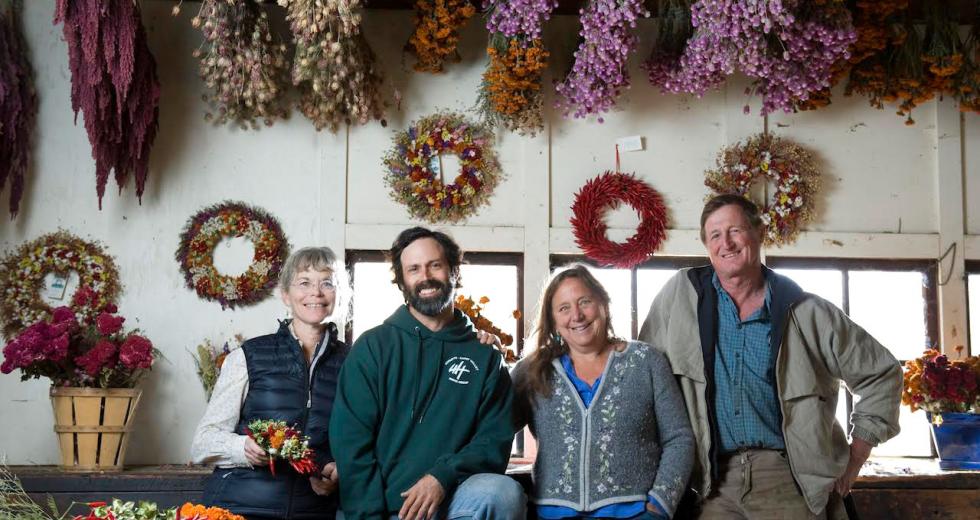Every week, 330 American farmers leave their land for good. And as an aging population of baby-boomer farmers retire, their jobs aren’t being filled quickly enough. Only six percent of all farmers are under the age of 35. But as the national food movement strengthens, will we see a return to farming? What about the children of these aging farmers — will they love their farm land or leave it?
Paul Muller of Fully Belly Farms is hopeful. At 62 years old, he falls right within the statistics of the aging farmer. But, in a country where only 24 percent of current farms are run by multiple generations, Muller says the odds are in his family’s favor. His children have already invested time, money and professional resources in the family farm — providing what he says is an informal succession plan he feels confident about. Muller and his wife, Dru Rivers, run the operation with their four adult children, all of whom bring fresh ideas — and revenue sources — with them.
Each of Muller’s children plays a unique role, having carved out their own enterprises within the larger family business. His older son, Amon, cooks freshly-harvested dinners on the farm in their new events center. Rye, the younger of the two sons, raises the farm’s livestock. Muller’s older daughter, Hallie Ochoa, grows flowers for weddings, while younger daughter Hannah oversees an annual harvest festival and runs children’s educational camps. Muller has seen a positive shift in the industry recently, even outside his household,
“The last five years have been golden years for ag,” he says. He points to an innovative generation of millennials who eschew the harsh economic realities of commodity farming — growing more but earning less — to search for more creative solutions. With an improved economy and innovative thinking, Muller sees agriculture booming again. He says agricultural tourism and a farm-to-fork focus on eating locally grown foods have helped infuse new revenue in farms like Full Belly, making it a more viable profession for young farmers.
“When I was a young man, most kids I knew wanted to get out of farming because it’s a difficult place to survive. The paradigm was to get big to stay in the business. It’s a contradiction that when farmers get paid slim margins their only option is to produce more with lower cost. That’s difficult to achieve.” Paul Muller, owner, Full Belly Farms
“When I was a young man, most kids I knew wanted to get out of farming because it’s a difficult place to survive,” he says. “The paradigm was to get big to stay in the business. It was pretty thin margins. It’s a contradiction that when farmers get paid slim margins their only option is to produce more with lower cost. That’s difficult to achieve.”
Locally, programs like Soil Born Farms and the Center for Land-Based Learning have started training programs to meet the growing demand for new farmers. Five years ago, CLBL began its California Farm Academy which has already trained 58 new farmers: That’s an impressive local statistic when nationally, the number of new farmers dropped 20 percent between 2007 and 2012.
Muller has seen this new generation of farmers, his children included, approach the business with more creativity, which allows farms like Full Belly to grow financially without relying on old methods of expansion.
“Land is limited in Capay Valley,” explains Ochoa. “The [traditional] inclination when you return to a farm is that you have to grow in acreage, but we want to grow vertically. How can we stack enterprises on this little piece of land without feeling we have to grow it out, but up?”
Rather than buying more acreage to grow more of the same crops, Full Belly Farms offers a wide range of products and services. From summer camps to on-site special events, each enterprise is overseen by a different family member. This offers everyone a rewarding sense of ownership; it also provides market flexibility. One example: In times of drought, farm dinners and tours are a growing, steady source of income.
Ochoa understands why some kids end up leaving the family farm. It’s a hard way to earn a living. Their typical workday is 10 to 12 hours. She grew up watching her parents work long days and accompanied them to the farmers markets on weekends. She values the strong work ethic they taught her, and says the benefits of farming with her family outweigh the challenges.
“Our family gets along bizarrely well,” she says. “After working 12-hour days, we still want to spend time with each other. I feel really lucky.”



